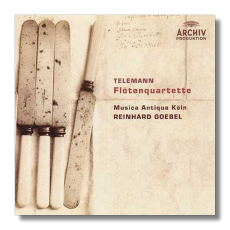
The Internet's Premier Classical Music Source
Related Links
- Telemann Reviews
- Latest Reviews
- More Reviews
-
By Composer
-
Collections
DVD & Blu-ray
Books
Concert Reviews
Articles/Interviews
Software
Audio
Search Amazon
Recommended Links
Site News
 CD Review
CD Review
Georg Philipp Telemann

Quadro Sonatas
- Flute Quartet in G minor, TWV 43:g4
- Flute Quartet in G Major, TWV 43:G6
- Flute Quartet in D minor, TWV 43:d3
- Flute Quartet in G Major, TWV 43:G11
- Flute Quartet in A minor, TWV 43:a3
- Flute Quartet in G Major, TWV 43:G12
- Flute Quartet in B Flat Major, TWV 43:B2
- Flute Quartet in G Major, TWV 43:G10
Musica Antiqua Köln/Reinhard Goebel
Deutsche Grammophon Archiv 477537-9 DDD 70:02
Telemann referred to these works has "quadros," indicating that they had four parts. The more sonata-like quadri treated the three upper voices fairly equally. Other quadros were more concerto-like, in that one of the voices – in this case, usually the transverse flute or the recorder – was more prominent. (In fact, sometimes these quadros are actually referred to as concertos. How's that for confusing?) In both cases, the bottom voice plays a role analogous to that of the basso continuo. Examples of both are included here. All of the quadros are in three or four movements.
There was a time not long ago when Telemann, like Vivaldi, was thought to be dull and repetitious. Goebel and MAK have given us many reasons to disagree over the past thirty-some years, and the music that is presented here is among the most delightful yet. It is mellow, warm-hearted, and always inventive. In fact, there are passages in several of these works – TWV 43:G6, for example – where the charm and intelligence of Bach's Brandenburg Concertos come to mind. While this music will serve nicely as Tafelmusik (to allude to another one of Telemann's works), it's nice to settle down on the couch and give it one's full attention.
There have been times when Goebel and MAK went a little overboard with fast tempos, but nothing sounds breathless here. Everything dances most beguilingly, and the playing is very stylish. The featured musicians are transverse flutist Verena Fischer and recorder player Maurice Steger. Goebel still participates as a violinist in several of the quadros. The engineering afforded the musicians is warm and intimate.
Quadros from TWV 43 have been included on several discs, including those by the Ensemble Senario (Globe) and the Limoges Baroque Ensemble (Astrée Auvidis). Telemann wrote many of these quadros, however, so there is little duplication, but ample opportunity to immerse oneself in a reinvigorating musical balm. Very enjoyable, and therefore duly recommended.
Copyright © 2005, Raymond Tuttle




















